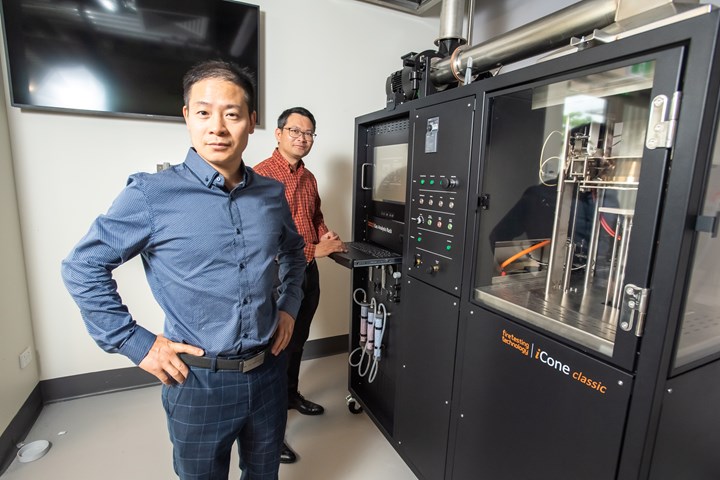UniSQ fire-retardant resins development bolster bushfire mitigation
The University of Southern Queensland has received funding to be used in the development of cost-effective composite resins to increase the resilience of wind turbine blades against bushfire exposure.
University of Southern Queensland’s Professor Pingan Song (right) and Professor Xuesen Zeng (left). Photo Credit: UniSQ
Australia’s changing climatic conditions and preparation for more extreme weather events are a constant reminder about the need for adaptation and resilience in new infrastructure. To tackle this issue, the Australian Research Centre (ARC) has awarded the University of Southern Queensland (UniSQ, Australia) $440,000, through the Linkage Projects strategy, to develop advanced fire-retardant composite resins used for manufacturing wind turbine blades and materials capable of withstanding exposure to bushfires.
The strategy is an Australian government initiative that unites researchers, industry partners and community groups to help advance the country’s skills and knowledge in various sectors.
UniSQ researchers Professor Pingan Song, a chemical engineer, and Professor Xuesen Zeng, a materials engineer, are using their expertise in fire-retardants and functional polymer composites to aid UniSQ in its endeavor to mitigate infrastructure risks and enhance bushfire resilience.
Song will lead the newly funded project. His aim is to develop and commercialize a new class of eco-friendly and cost-effective fire retardants that can improve the fire retardancy of unsaturated polyester resins (UPR) by creating a protective char layer while preserving the UPR’s bulk physical properties. Song says the project will build on the university’s collaboration with Allnex Resins Australia (Botany, New South Wales), which have worked together for the past five years developing advanced composites manufacturing for electrical infrastructures, such as power poles.
“We are 100% confident that we can achieve our aims because we have all the required resources in place,” Song says. “Moreover, we have already achieved some encouraging preliminary research results, which means we are already on the right track.”
Working alongside industry partners Ningbo MIRUO Electronic Technology (Ningbo, China) and Allnex Composites Australia, Song adds that the “next generation” technology will capture the attention of the world’s manufacturing sector.
“The ultimate goal is for the technology to be used in many other constructions and infrastructures, including transport and power facilities,” he says.
Others involved in the research team include Dr. Zhenhu Cao (Ningbo MIRUO Electronic Technology) and Dean Voice (Allnex Composites Australia).
Related Content
-
Welding is not bonding
Discussion of the issues in our understanding of thermoplastic composite welded structures and certification of the latest materials and welding technologies for future airframes.
-
Plant tour: Airbus, Illescas, Spain
Airbus’ Illescas facility, featuring highly automated composites processes for the A350 lower wing cover and one-piece Section 19 fuselage barrels, works toward production ramp-ups and next-generation aircraft.
-
Plant tour: Joby Aviation, Marina, Calif., U.S.
As the advanced air mobility market begins to take shape, market leader Joby Aviation works to industrialize composites manufacturing for its first-generation, composites-intensive, all-electric air taxi.

















